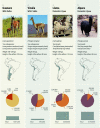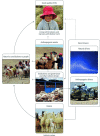South American Camelids: their values and contributions to people
- PMID: 33133295
- PMCID: PMC7586864
- DOI: 10.1007/s11625-020-00874-y
South American Camelids: their values and contributions to people
Abstract
South American Camelids (SACs) make several material and non-material contributions to people and are a key component of the Andean biocultural heritage. From the perspective of the IPBES' Conceptual Framework, SACs constitute the "nature" component in the complex system of interactions between human societies and the Andean mountain environment. There are four SAC living species today, two of which are wild, or Salqa, in the indigenous cosmovision: guanaco (Lama guanicoe) and vicuña (Vicugna vicugna). Llama (Lama glama) and alpaca (Vicugna pacos) were domesticated 5000 years ago, and are therefore Uywa, in the indigenous cosmovision. Both wild and domestic camelids were, and in several cases still are, the most highly appreciated resource for Andean livelihoods. Historically, camelids and their contributions have been used by Andean people since the peopling of the Americas over 11,000 years ago. In this paper, we present three case studies (chakus for vicuña management, llama caravans, and llama nanobodies) to bring attention to the essential role of vicuñas and llamas for Andean communities today, their intercultural linkages with the Western world, and telecoupling interactions.
Keywords: Andean altiplano; Lama glama; NCP; Nature contribution to people; Values; Vicugna vicugna.
© Springer Japan KK, part of Springer Nature 2020.
Figures



References
-
- Aagesen D. Crisis and conservation at the end of the world: sheep ranching in Argentine Patagonia. Environ Conserv. 2000;27:208–215. doi: 10.1017/S0376892900000229. - DOI
-
- Acebes P, Wheeler J, Baldo J, Tuppia P, Lichtenstein G, Hoces D, Franklin WL. Vicugna vicugna. IUCN Red List Threatened Species. 2018 doi: 10.2305/IUCN.UK.2018-2.RLTS.T22956A145360542.en. - DOI
-
- Arzamendia Y, Vilá B. Effects of capture, shearing and release on the ecology and behavior of wild Vicuña. J Wildl Manage. 2012;76:54–64. doi: 10.1002/jwmg.242. - DOI
LinkOut - more resources
Full Text Sources
